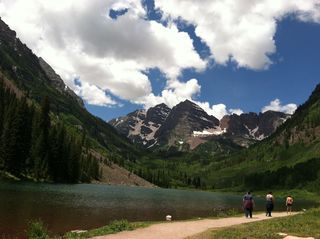Stress
Coping With Technostress
The healing power of nature and managing technostress
Posted August 27, 2019
“The mountains are calling and I must go.”
― John Muir

Most of us spend hours each day in artificial light, working at computers, on our cell phones, in our comfortable air-conditioned or heated homes. In our connected world, most of us continuously multi-task. We rush from activity to activity, we simultaneously talk on our phones while we work on the computer, and eat our lunch. On weekends and holidays, we answer emails on our phones. We are constantly bombarded with technological demands. It is unusual to have a free day or even an hour. The majority of Americans do not spend enough time in nature (Case, Mikels-Carrasco, Seng, and Witter, 2019). There is nothing that aids in stress management so much as a day spent in nature, in the woods, the mountain, on the beach. Nature never disappoints. Spending time in nature heals the body and the soul. It reduces blood pressure, lowers heart rate, relaxes muscles, and lowers the stress hormones.
Humans have spent most of their history living in the natural world. Contemporary industrialized societies have created artificial workspaces. Our constant need to be connected to social media has tied to us to technology. Our exhaustion has resulted in many sedentary hours watching our devices, possibly while we consume unhealthy snacks. These joys and ills of contemporary life combine to increase stress levels to unhealthy levels. Social and cultural change related to an increasing dependence on computers has led to an associated increase in “technostress.” This term first coined in the 1980s by Brod (1984) focuses on the ways that increase in exposure to technology and long hours spent on the computer has increased people’s stress levels and lowered well-being. It is not surprising that people spend their vacations attempting to reconnect with nature. A week at the beach, or on a lake, or in the mounts, is healing and restorative. Why do psychologists and physicals not make greater use of this free therapeutic method accessible to everyone? Research tells us that exposure to natural settings helps restore a person to a state of relaxation.
There has been some attention to various ways that nature can “heal.” Forest therapy, for example, called “Shinrin-yoku” in Japan, focuses on engaging the senses and taking in the “forest.” It is a health promotion method that has shown that a natural forest environment can improve well-being. Studies indicated that simply walking in a forest environment for a 15-minute tended to induce an increased state of physiological relaxation (Song, Ikei, Park, Lee, Kagawa, & Miyazaki, 2018; Tsunetsugu, Park, Ishii, Hirano, Kagawa, and Miyazaki, 2007). In fact, more than 30 years ago, the Japanese government introduced “forest bathing,” encouraging people to go into the countries woods for therapy (Hansen, Jobes, & Tocchini, 2017).
Not everyone has easy access to mountains and lakes, however, even for those living in urban spaces can improve their well-being by spending 30 minutes in a park or community garden. Having regular access to a green space even increases longevity (United States Department of Agriculture, 2018). By contrast, nature deprivation is negatively impacting the health and happiness of people of all ages. The epidemic increase in stress-related illnesses, depression, and anxiety is partially associated with our increasing alienation from nature.
Unless one chose to live off the grid it is impossible to avoid some hours of life spent in an artificial setting, tied to technological devices.
Techno-stress affects most of us (Fisher & Riedl, 2017). Techno-stress can be understood from a well-known psychological theory describing stress management.
This theory introduced by two psychologists, Lazarus and Folkman’s (1984) is called the transactional model of stress. The theory explains that the negative effects of stress are dependent more on how someone understands their stress, in other words, do most of us feel we can cope with the stress in our lives or do we feel overpowered by it.
By all accounts, a little time in nature is likely to increase our ability to feel that we can, indeed, cope with our day to day stress.
Time in nature is one ready resource available to most people of all ages and backgrounds. In other words, hours spend on the computer in an anticlinal environment may be perceived as a stressful but the stressors can be seen as more manageable and bearable if at the day one can look forward to a walk in the woods, in a park, or on the beach. As Ralph Waldo Emerson claimed in his 1836 essay Nature – “In the woods,” he wrote, “I feel that nothing can befall me [. . .] which nature cannot repair.”
When I was growing up, each weekend we would go for a picnic in the mountains or the woods. These weekend activities, where we would spend a few hours away from everything that needed to be done, were healing, connecting, and rejuvenating. This was before we took our cell phones and iPad, so the day was truly “off the grid”.
Americans today have fewer vacation days than any other technologically advanced country. Studies show that many Americans are even afraid to take the vacation days they have earned for (a) fear of falling behind in their work or (b) being perceived as unmotivated. When Americans do manage to get away, they stay “connected” through computers, iPhones, and iPads. Vacations become as frantic as workdays. People return to work, not renewed and refreshed. Spending a day truly in nature can improve immune functions, prevent illnesses, and maintain and promote health.
Ecotherapy or nature therapy is free, we only need to make time for it. A 2007 study in England found that a daily dose of walking outside could be as effective as taking antidepressant drugs. Time spent in nature also has no side effects. It will reduce stress and promote healing.
References
Case, D. J., Mikels-Carrasco, J., Seng, P. T., and Witter, D. J. (2019). Americans spend little time outside weekly. The Nature of Americans. Retrieved from https://natureofamericans.org/findings/viz/adults-spend-little-time-out…
Hansen, M., Jobes, R., and Tocchini, K. (2017). Shinrin-Yoku (Forest Bathing) and Nature Therapy: A State-of-the-Art Review. International Journal of Environment Research and Public Health, doi: 10.3390/ijerph14080851
Song, C., Ikei, H., Park, B, Lee, J., Kagawa, T, and Miyazaki, Y. (2018) Psychological benefits of walking through forest areas. International Journal of Environment Research and Public Health, doi: 10.3390/ijerph15122804
Tsunetsugu, Y., Park, B., Ishii, H., Hirano, H., Kagawa, T., and Miyazaki, Y. (2007). Physiological effects of Shinrin-yoku (taking in the atmosphere of the forest) in an old-growth broadleaf forest in Yamagata Prefecture, Japan. Journal of Physiological Anthropology. 26. 135-42. 10.2114/jpa2.26.135.
United States Department of Agriculture. (2018). Urban nature for human health and well-being: A research summary for communicating the health benefits of urban trees and green space. FS-1096. Retrieved from https://www.fs.fed.us/sites/default/files/fs_media/fs_document/urbannat…




